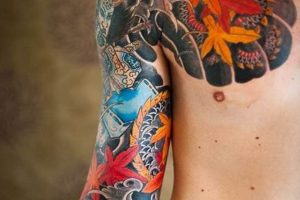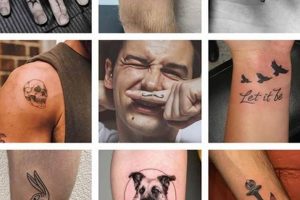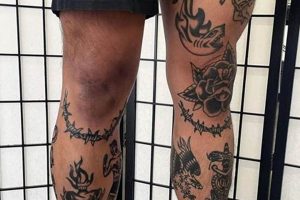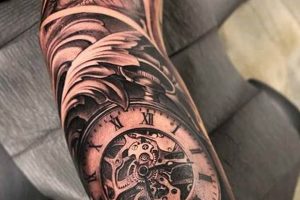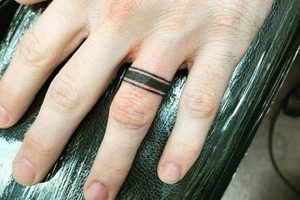A full arm tattoo, often referred to as a “sleeve,” presents a large canvas for artistic expression. It allows for complex designs incorporating various elements, styles, and symbolism, creating a unified and visually striking piece of body art. For example, a nature-themed sleeve might seamlessly blend images of forests, mountains, and animals, while a geometric sleeve could explore intricate patterns and shapes.
Such extensive body art offers a unique opportunity for self-expression, allowing individuals to showcase passions, beliefs, or significant life events. The enduring nature of tattoos transforms the body into a living, evolving narrative. Historically, full arm tattoos have held cultural significance in various societies, symbolizing status, group affiliation, or spiritual beliefs. Today, they continue to be a powerful form of personal expression, albeit with broader interpretations and artistic possibilities.
The process of designing and executing a cohesive, full-arm piece requires careful planning and collaboration between the client and the tattoo artist. Key considerations include theme selection, style coherence, and color palette. Further exploration will cover the diverse range of stylistic options, the significance of finding a skilled artist, and the importance of aftercare for preserving the artwork’s vibrancy and longevity.
Tips for Planning a Full Sleeve Tattoo
Careful planning is essential for a successful full sleeve tattoo. These tips provide guidance for navigating the process effectively.
Tip 1: Theme Selection: A unifying theme provides coherence and visual impact. Consider passions, interests, or life experiences for inspiration. Examples include nature, mythology, music, or abstract concepts.
Tip 2: Research and Style Exploration: Explore various tattoo styles (realism, traditional, Japanese, etc.) to find one that aligns with the chosen theme and personal aesthetics. Review portfolios of different artists specializing in the preferred style.
Tip 3: Artist Selection: A skilled artist is crucial. Seek recommendations, examine portfolios, and schedule consultations to discuss the project and assess compatibility.
Tip 4: Budget Considerations: Full sleeve tattoos are significant investments. Establish a realistic budget early in the planning process.
Tip 5: Collaboration and Design Development: Work closely with the chosen artist to develop a cohesive design. Clear communication ensures the final result reflects the desired vision.
Tip 6: Time Commitment: Completing a full sleeve requires multiple sessions over an extended period. Be prepared for the time commitment and potential discomfort involved.
Tip 7: Aftercare: Proper aftercare is crucial for preserving the tattoo’s vibrancy and preventing complications. Follow the artist’s instructions diligently.
By following these guidelines, individuals can ensure a positive and fulfilling experience, resulting in a meaningful and visually stunning piece of body art.
These considerations are crucial for achieving a successful and satisfying outcome, transitioning seamlessly into a final discussion of long-term care and artistic evolution.
1. Theme
Theme selection serves as the foundation of a successful full sleeve tattoo. A well-defined theme provides cohesion and narrative depth, transforming a collection of individual elements into a unified and meaningful artwork. A clear thematic focus guides design choices, ensuring a harmonious and impactful visual narrative. For example, a theme of “exploration” could incorporate imagery of maps, compasses, ships, and celestial bodies, reflecting a passion for travel and discovery. Alternatively, a theme centered around “family heritage” might feature portraits, family crests, or symbolic representations of cultural traditions.
Thematic coherence strengthens the visual impact of a sleeve tattoo, allowing for a richer and more layered interpretation. Without a unifying theme, a sleeve can appear disjointed and lack a sense of purpose. A strong theme allows for greater artistic expression and enables the wearer to communicate a complex narrative. Consider a sleeve focusing on “inner strength.” This could be visually represented through imagery of powerful animals, warriors, or symbolic elements representing resilience and perseverance. Such thematic consistency enhances the storytelling potential of the artwork.
Careful consideration of thematic resonance ensures the tattoo remains personally meaningful over time. A theme deeply connected to the individual’s values, beliefs, or life experiences fosters a stronger sense of ownership and pride. Selecting a theme that holds personal significance contributes to the longevity of the tattoo’s meaning, ensuring it remains relevant and resonant throughout life’s journey. This careful selection process transforms a full sleeve tattoo into a powerful and enduring form of self-expression.
2. Style
Style selection is paramount in realizing a compelling and cohesive full sleeve tattoo. The chosen style dictates the visual language of the artwork, influencing its aesthetic impact and overall message. From the bold lines and vibrant colors of traditional Americana to the intricate detail and subtle shading of realism, the chosen style profoundly shapes the final result. Understanding the nuances of various styles allows for informed decision-making, aligning artistic vision with personal aesthetics.
- Realism
Realism focuses on replicating real-world imagery with meticulous detail. Portraits, landscapes, and depictions of animals are common subjects. A realistic sleeve might feature a detailed portrait of a loved one or a stunning nature scene, prioritizing accuracy and visual fidelity. This style demands a highly skilled artist capable of capturing intricate details and subtle nuances.
- Traditional
Traditional, or American Traditional, tattooing employs bold lines, vibrant colors, and iconic imagery. Common motifs include anchors, eagles, roses, and pin-up girls. A traditional sleeve often features a collection of these classic elements, creating a bold and timeless statement. This style emphasizes clean lines and strong visual impact.
- Japanese
Japanese tattooing, or Irezumi, is characterized by its intricate detail, vibrant colors, and flowing compositions. Common themes include mythical creatures, samurai warriors, and traditional Japanese imagery. A Japanese-style sleeve often incorporates these elements into a dynamic and visually captivating narrative. This style requires a deep understanding of Japanese culture and artistic traditions.
- Geometric/Abstract
Geometric and abstract styles emphasize shapes, patterns, and lines, often creating visually striking and non-representational designs. A geometric sleeve might feature intricate mandalas, tessellations, or abstract patterns, offering a modern and unique aesthetic. This style allows for creative exploration of form and composition.
Ultimately, the chosen style should complement the selected theme and reflect the individual’s personal aesthetic preferences. Careful consideration of these factors ensures a cohesive and impactful full sleeve tattoo that resonates with the wearer for years to come. Harmonizing theme and style creates a unified artistic statement, transforming the body into a canvas for self-expression.
3. Placement
Placement considerations are integral to the overall impact and personal significance of a full sleeve tattoo. The location of the artwork on the arm influences its visibility, readability, and how it interacts with the body’s natural contours. Careful planning ensures the design complements the arm’s shape and effectively conveys the intended narrative.
- Inner vs. Outer Arm
The inner arm offers a more private canvas, suitable for designs with personal meaning. The outer arm provides greater visibility, allowing for bolder statements. Choosing between these locations depends on individual preferences and the intended message of the tattoo. An intricate, symbolic design might be placed on the inner arm for personal reflection, while a bold, illustrative piece could adorn the outer arm for public display.
- Shoulder to Wrist Flow
The natural flow of the arm from shoulder to wrist provides opportunities for dynamic compositions. Elements can be strategically placed to create visual movement and guide the viewer’s eye along the arm. A design might begin with larger elements at the shoulder, gradually transitioning to smaller, more intricate details towards the wrist, creating a sense of visual progression.
- Muscle Definition and Body Contours
The musculature of the arm can be incorporated into the design, enhancing its three-dimensional form and visual impact. Skilled artists can use the contours of the body to create the illusion of depth and movement within the tattoo. For example, a design might flow around the biceps or triceps, accentuating the muscle definition and creating a more dynamic composition.
- Dominant vs. Non-Dominant Arm
The choice between the dominant and non-dominant arm can influence the tattooing process and the visibility of the artwork. The non-dominant arm is often preferred for initial sessions, allowing for greater comfort and control during the process. The dominant arm offers higher visibility, showcasing the tattoo more prominently. This decision involves balancing practical considerations with personal preferences.
Strategic placement choices enhance the aesthetic impact and personal meaning of a full sleeve tattoo. By considering these factors, individuals can ensure the design harmonizes with the body’s natural form and effectively communicates the intended narrative. Careful consideration of placement transforms the arm into a dynamic canvas, showcasing the artwork to its fullest potential.
4. Artist Collaboration
Effective artist collaboration is paramount in realizing a successful and meaningful full sleeve tattoo. This collaborative process transforms a conceptual idea into a tangible piece of art, requiring clear communication, mutual understanding, and a shared artistic vision. The client’s input provides the foundationpersonal narratives, stylistic preferences, and thematic desireswhile the artist’s expertise translates these concepts into a cohesive and visually compelling design. A successful collaboration ensures the final artwork reflects the client’s vision while benefiting from the artist’s technical skill and artistic interpretation. For example, a client might envision a sleeve incorporating elements of Japanese folklore, but lack the specific visual vocabulary to articulate the concept fully. A skilled artist can provide guidance on appropriate imagery, composition, and stylistic nuances, enriching the initial idea and ensuring a cohesive final product. Conversely, an artist might suggest alternative interpretations or design elements that enhance the client’s original vision, contributing to a richer and more nuanced final piece.
The collaborative process typically involves multiple consultations, sketches, and revisions. Open communication throughout these stages is essential for addressing concerns, refining details, and ensuring the design aligns with the client’s evolving vision. This iterative process allows for adjustments and refinements, guaranteeing the final artwork meets the client’s expectations and reflects their unique personality and narrative. A client might initially request a realistic portrait, but through discussions with the artist, discover that a more stylized approach better captures the essence of the subject. This flexibility and ongoing dialogue are crucial for achieving a satisfying outcome. Furthermore, a collaborative approach allows the artist to tailor the design to the client’s individual anatomy, ensuring the artwork flows seamlessly with the body’s natural contours and complements the client’s physique.
Successful artist collaboration elevates a full sleeve tattoo from a mere decoration to a powerful form of self-expression. The collaborative process ensures the artwork reflects the client’s unique identity, values, and aspirations, transforming the body into a living canvas. Challenges might arise from differing artistic visions or communication barriers, underscoring the importance of selecting an artist whose style and communication approach align with the client’s preferences. Ultimately, a strong artist-client relationship built on trust, mutual respect, and open communication is the cornerstone of a successful and meaningful full sleeve tattoo experience, resulting in a piece of art that resonates deeply with the wearer for years to come.
5. Long-Term Vision
Long-term vision is crucial when considering a full sleeve tattoo. Given the permanence and scale of the artwork, planning beyond the initial design is essential for ensuring the tattoo remains aesthetically pleasing and personally meaningful over time. A thoughtful long-term vision considers potential additions, stylistic evolution, and the evolving nature of personal narratives, preventing a visually disjointed or narratively inconsistent final result.
- Future Additions and Expansions
Planning for potential future additions ensures thematic and stylistic coherence as the sleeve evolves. Leaving strategic negative space or incorporating design elements that can be expanded upon later allows for seamless integration of new imagery. For instance, a sleeve initially focused on aquatic life could later incorporate terrestrial elements, expanding the theme of nature without disrupting the existing artwork. This foresight prevents a cluttered or disjointed appearance as the sleeve progresses.
- Stylistic Consistency and Evolution
Maintaining stylistic consistency across multiple sessions, even with different artists, is vital for a cohesive final product. Clear documentation of the initial style, color palette, and techniques used allows for seamless continuation, even years later. While personal style may evolve, ensuring new additions complement the existing work prevents stylistic clashes. Imagine a sleeve begun in a traditional Japanese style; subsequent additions in a photorealistic style would create a jarring visual disconnect.
- Adapting to Life Changes and Evolving Narratives
Life experiences and personal narratives evolve over time. A long-term vision anticipates these changes and considers how the tattoo can adapt to reflect personal growth. Symbolic imagery or design elements that allow for multiple interpretations provide flexibility as life unfolds. A sleeve depicting a journey could incorporate new symbols or landmarks representing significant life events, allowing the tattoo to evolve alongside the individual.
- Aging and Skin Changes
Considering the long-term effects of aging and skin changes on the tattoo is essential. Bold lines and larger elements tend to age better than fine details, which can blur over time. Choosing a style and color palette that will age gracefully ensures the tattoo retains its visual appeal for decades. A sleeve composed of intricate, fine-line details may lose clarity over time, while a bolder, traditional design will likely retain its visual impact.
A comprehensive long-term vision ensures the full sleeve tattoo remains a source of pride and personal expression throughout life. By anticipating future additions, maintaining stylistic coherence, and acknowledging the evolving nature of personal narratives, individuals can create a timeless piece of art that reflects their journey and continues to resonate with meaning over time. This proactive approach elevates the full sleeve tattoo from a static image to a dynamic and evolving narrative etched onto the skin.
Frequently Asked Questions
This section addresses common inquiries regarding full sleeve tattoos, providing concise and informative responses to facilitate informed decision-making.
Question 1: What is the typical cost of a full sleeve tattoo?
The cost varies significantly based on factors such as artist experience, geographic location, design complexity, and the number of sessions required. A reasonable estimate ranges from several thousand dollars to upwards of ten thousand dollars. Obtaining quotes from multiple reputable artists is recommended.
Question 2: How long does it take to complete a full sleeve tattoo?
Completion time depends on the design’s intricacy, individual pain tolerance, and scheduling availability with the chosen artist. A full sleeve typically requires multiple sessions, each lasting several hours, spread over several months or even a year.
Question 3: Is a full sleeve tattoo more painful than smaller tattoos?
Pain levels vary by individual and location on the arm. Areas with thinner skin or closer proximity to bone may experience greater sensitivity. The extended duration of multiple sessions contributes to overall discomfort, but experienced artists employ techniques to minimize pain.
Question 4: What is the best way to find a reputable tattoo artist for a full sleeve?
Thorough research is crucial. Recommendations from trusted sources, online portfolio reviews, and consultations with multiple artists help assess experience, style, and compatibility. Verifying licensing and adherence to hygiene standards is essential.
Question 5: How should a full sleeve tattoo be cared for during the healing process?
Proper aftercare is critical for preventing infection and ensuring optimal healing. Following the artist’s specific aftercare instructions diligently, which typically involve keeping the tattoo clean, moisturized, and protected from sun exposure, is vital.
Question 6: Can a full sleeve tattoo be removed or covered up?
While laser removal is possible, it is a costly, time-consuming, and often incomplete process. Covering a full sleeve with another tattoo presents significant artistic challenges, requiring a highly skilled artist specializing in cover-ups. Careful consideration of the long-term implications of a full sleeve tattoo is advised before commitment.
Thorough research and careful planning are essential for a positive and successful full sleeve tattoo experience. Addressing these common concerns facilitates informed decision-making, ensuring the process aligns with individual expectations and desired outcomes.
This information provides a comprehensive overview, transitioning seamlessly into a concluding summary of key considerations and a call to action.
Conclusion
A full sleeve tattoo represents a significant commitment, offering a powerful canvas for self-expression and artistic exploration. Careful consideration of theme, style, placement, artist collaboration, and long-term vision is crucial for a successful outcome. Thematic coherence ensures a unified narrative, while stylistic choices dictate the visual language of the artwork. Strategic placement enhances the design’s impact, and effective artist collaboration translates personal vision into a tangible reality. A long-term perspective anticipates future additions and stylistic evolution, ensuring the tattoo remains relevant and aesthetically pleasing over time. These considerations transform the full sleeve tattoo from a simple decoration into a dynamic and evolving personal narrative.
The process of designing and acquiring a full sleeve tattoo demands thoughtful planning and diligent execution. Thorough research, open communication, and a commitment to aftercare are essential for realizing a meaningful and enduring piece of art. The full sleeve tattoo offers a unique opportunity to transform the body into a living canvas, expressing personal narratives, values, and aspirations through the powerful medium of body art. This journey of self-expression requires dedication, patience, and a deep understanding of the artistic and personal significance embodied within the full sleeve tattoo.



